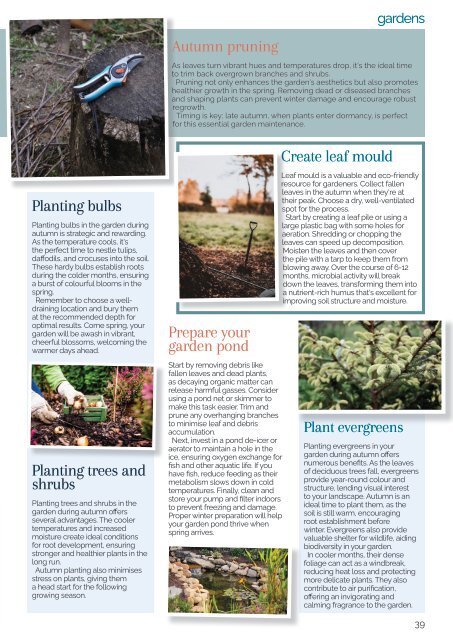Whitchurch and Llandaff Living Issue 68
Issue 68 of the award-winning Whitchurch and Llandaff Living magazine.
Issue 68 of the award-winning Whitchurch and Llandaff Living magazine.
You also want an ePaper? Increase the reach of your titles
YUMPU automatically turns print PDFs into web optimized ePapers that Google loves.
Autumn pruning<br />
gardens<br />
As leaves turn vibrant hues <strong>and</strong> temperatures drop, it's the ideal time<br />
to trim back overgrown branches <strong>and</strong> shrubs.<br />
Pruning not only enhances the garden's aesthetics but also promotes<br />
healthier growth in the spring. Removing dead or diseased branches<br />
<strong>and</strong> shaping plants can prevent winter damage <strong>and</strong> encourage robust<br />
regrowth.<br />
Timing is key; late autumn, when plants enter dormancy, is perfect<br />
for this essential garden maintenance.<br />
Planting bulbs<br />
Planting bulbs in the garden during<br />
autumn is strategic <strong>and</strong> rewarding.<br />
As the temperature cools, it's<br />
the perfect time to nestle tulips,<br />
daffodils, <strong>and</strong> crocuses into the soil.<br />
These hardy bulbs establish roots<br />
during the colder months, ensuring<br />
a burst of colourful blooms in the<br />
spring.<br />
Remember to choose a welldraining<br />
location <strong>and</strong> bury them<br />
at the recommended depth for<br />
optimal results. Come spring, your<br />
garden will be awash in vibrant,<br />
cheerful blossoms, welcoming the<br />
warmer days ahead.<br />
Planting trees <strong>and</strong><br />
shrubs<br />
Planting trees <strong>and</strong> shrubs in the<br />
garden during autumn offers<br />
several advantages. The cooler<br />
temperatures <strong>and</strong> increased<br />
moisture create ideal conditions<br />
for root development, ensuring<br />
stronger <strong>and</strong> healthier plants in the<br />
long run.<br />
Autumn planting also minimises<br />
stress on plants, giving them<br />
a head start for the following<br />
growing season.<br />
Prepare your<br />
garden pond<br />
Start by removing debris like<br />
fallen leaves <strong>and</strong> dead plants,<br />
as decaying organic matter can<br />
release harmful gasses. Consider<br />
using a pond net or skimmer to<br />
make this task easier. Trim <strong>and</strong><br />
prune any overhanging branches<br />
to minimise leaf <strong>and</strong> debris<br />
accumulation.<br />
Next, invest in a pond de-icer or<br />
aerator to maintain a hole in the<br />
ice, ensuring oxygen exchange for<br />
fish <strong>and</strong> other aquatic life. If you<br />
have fish, reduce feeding as their<br />
metabolism slows down in cold<br />
temperatures. Finally, clean <strong>and</strong><br />
store your pump <strong>and</strong> filter indoors<br />
to prevent freezing <strong>and</strong> damage.<br />
Proper winter preparation will help<br />
your garden pond thrive when<br />
spring arrives.<br />
Create leaf mould<br />
Leaf mould is a valuable <strong>and</strong> eco-friendly<br />
resource for gardeners. Collect fallen<br />
leaves in the autumn when they're at<br />
their peak. Choose a dry, well-ventilated<br />
spot for the process.<br />
Start by creating a leaf pile or using a<br />
large plastic bag with some holes for<br />
aeration. Shredding or chopping the<br />
leaves can speed up decomposition.<br />
Moisten the leaves <strong>and</strong> then cover<br />
the pile with a tarp to keep them from<br />
blowing away. Over the course of 6-12<br />
months, microbial activity will break<br />
down the leaves, transforming them into<br />
a nutrient-rich humus that's excellent for<br />
improving soil structure <strong>and</strong> moisture.<br />
Plant evergreens<br />
Planting evergreens in your<br />
garden during autumn offers<br />
numerous benefits. As the leaves<br />
of deciduous trees fall, evergreens<br />
provide year-round colour <strong>and</strong><br />
structure, lending visual interest<br />
to your l<strong>and</strong>scape. Autumn is an<br />
ideal time to plant them, as the<br />
soil is still warm, encouraging<br />
root establishment before<br />
winter. Evergreens also provide<br />
valuable shelter for wildlife, aiding<br />
biodiversity in your garden.<br />
In cooler months, their dense<br />
foliage can act as a windbreak,<br />
reducing heat loss <strong>and</strong> protecting<br />
more delicate plants. They also<br />
contribute to air purification,<br />
offering an invigorating <strong>and</strong><br />
calming fragrance to the garden.<br />
39

















